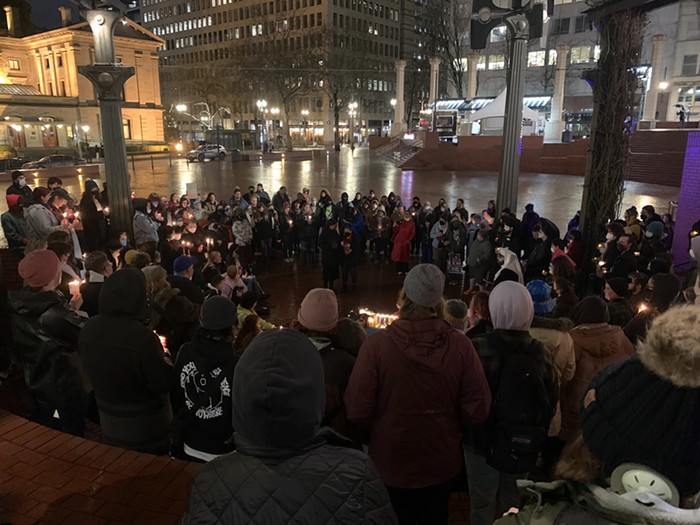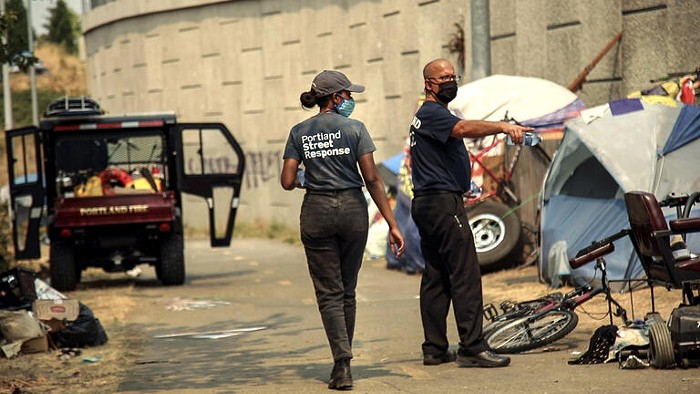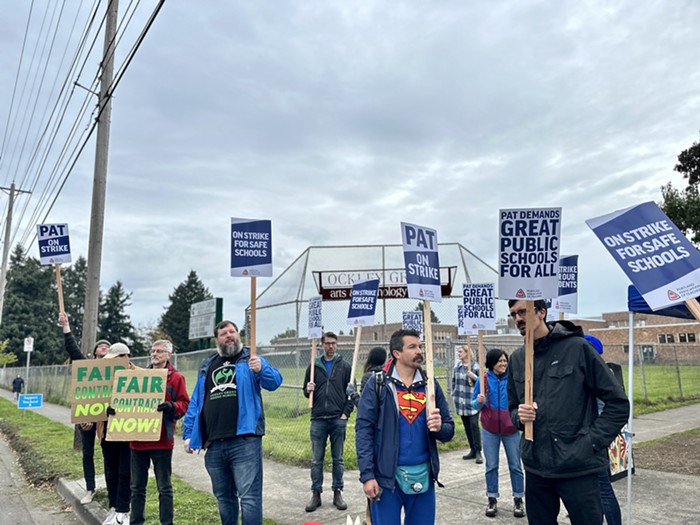AS A PAIR OF FIGHTER JETS rips through the clear blue sky overhead, I drive to the Portland Air National Guard Base to see if I can sneak my way in. I walk through the doors of the armory, past uniformed sergeants coming off duty, past the recruiting office. I'm looking for fifth graders.
Across the hall from a sign promising amnesty to anyone who turns in their illicit ammunition, there's a door with a crudely carved wooden sign: Starbase. I knock. No answer.
Every year a few of the city's cash-strapped public schools send busloads of fourth and fifth graders to this facility to participate in Starbase Portland. The kids are mostly from schools in low-income neighborhoods; Starbase is targeted at "at-risk" populations. It's a program in which they get 25 hours of instruction in physics, chemistry, and engineering over five days. And the US Department of Defense foots the bill.
I'm sneaking around because it has taken months for the people who run the program to grant me permission to visit, and I'm impatient. Starbase just got a renewal of its $320,000 grant from the government, thus sparking a new round of protests from activist parents. They say Starbase is a covert recruiting program that takes advantage of poor kids with few opportunities. They don't want their children exposed to the military.
•••
A month later, Starbase Portland Director Marilyn Sholian finally agrees to let me sit in on the classes. One morning she ferries me across the base's security checkpoint in her new-smelling Nissan.
"We don't get the feeling that anyone who's teaching here is recruiting," she explains. "But with all the protests that have been happening, parents are more aware of the program now. I'd rather have you write accurate information than bad information."
We pull up to an old barracks across from a chapel. Today's class is for students from Woodmere Elementary in Southeast Portland's Brentwood-Darlington neighborhood, where 87 percent of students are poor enough to qualify for free or reduced-priced lunch. The kids sit four to a table in a room where 50 soldiers used to sleep. There are still showers in the men's room. Standing at the center of the room is Roy Chambers, the science teacher you wish you'd had: A mellow, affable nerd with a gray ponytail, he talks to the kids in grown-up sentences, stopping to make sure they understand. After a lecture on chemical reactions, the first order of business will be to combine various substances in test tubes to see how much they fizz.
•••
Chambers was a middle-school science teacher for Portland Public Schools (PPS), and later a department specialist in charge of curriculum development and teacher training. According to Chambers, he became embroiled in some nasty politics that he doesn't want to talk about, and was eventually reassigned to Starbase as a member of the program's teaching staff—all PPS teachers. He teaches six groups of kids a month, based on a curriculum designed by the defense department.
"I love this job," he says. "I really believe in the middle school model, where teachers can specialize in one subject."
The kids seem to agree, and generally they are more engaged with the classes than with the soldiers and weaponry outside the windows. In another class, I ask fourth grader Chase why he thinks they travel all the way out to a military base to learn this stuff.
"It's more interesting here," he says, after contemplating for a few moments. "Back at school, our teacher has to teach all kinds of stuff. But Mr. Chambers really knows what he's talking about, because he can just focus on science."
Most public school teachers these days are focusing on standardized test preparation rather than experiential learning. Declining budgets are also an issue.
"If we had enough money we'd have a science specialist in every building," says Chambers.
As it stands, according to Sholian, "Starbase is all the science a kid may get."
In other words, maybe it would be perfectly uncontroversial—if someone else were paying for it.
•••
I arrive at the base one morning to find that Barbara Koscak—who created the Starbase program and now works full-time for the defense department—has flown out to meet me. She oversees 60 Starbase sites on military bases across the country, costing the government a total of $19 million a year.
Koscak spent 15 years as an elementary school teacher in Michigan, where she noticed that kids were losing their ability to learn hands-on subjects.
"We were losing girls and minorities in science and math by eighth grade," she says. "I saw the need for students to be exposed to all subjects."
Koscak thought that a military base would be a perfect place for this to happen. She thought about what interests young kids: "airplanes, ghosts, and dinosaurs." Since the latter two would be hard to find, she decided to build a program around kids' love for fast, shiny machines—a love that she shared.
"When I was a kid, I wanted to be a fighter pilot in the worst way. I never gave up on that dream," Koscak says. She eventually flew in an F-16 with her friend Rico Racosky. He helped Koscak and a group of volunteer teachers start the precursor to the Starbase program at Selfridge Air National Guard Base in Michigan in the summer of 1990.
Aren't fifth graders—at least the boys—also fascinated by guns and explosions? Koscak says that's never been an issue: "It's not here. It's not shown to them. The kids don't have time to ask, 'Is that airplane going to kill somebody?'"
However, that question does arise on base tour day, when Sergeant Stan Durfee shows the class the parts of an F-15 Eagle while a uniformed escort follows me around, making sure I don't take any pictures.
"Where has this airplane been?" asks one of the students.
"I don't know if it's been anywhere," answers Durfee. "That's not its job right now."
Roy Chambers is taking kids in groups of four up a staircase to look inside the cockpit. "These planes don't carry bombs or guns," he tells one group.
"Yeah, they do!" yells a boy, pointing to a Gatling gun and missile brackets near the base of the wing.
"They don't even load them," says Chambers, probably wishing I weren't there. "These planes are for observation."
•••
While the kids use what they learned about fighter jets to build paper gliders in the classroom, I ask Koscak if she's ever had reservations about placing large numbers of kids within feet of heavy weapons.
"Gosh, I never had that," she says. "I never thought of it. Sorry."
Koscak's phone rings and she excuses herself. "Pentagon," she mouths, heading to the door.
After setting up the first program at Selfridge with funding from a W.K. Kellogg Foundation grant, Koscak was looking to expand. She contacted Michigan Senator Carl Levin and asked him if the federal government could supply a more permanent source of funding. Working with members of the Senate Armed Services Committee, Levin helped procure federal dollars for the program in 1993. A multi-state expansion followed soon after.
You may wonder, as I did, what benefit the US Department of Defense sees in dropping $19 million a year to let kids across the country experiment with vinegar and baking soda on federal property.
Jessica Applegate-Brown, a parent who organized Portland's first anti-Starbase protest at Winterhaven School in 2006, says it's an early recruiting investment designed to give kids a good impression of the military.
"Why else would the department of defense be paying us?" she asks. "Out of the goodness of their hearts?"
Exactly, says Koscak.
"They're giving back to the community," she says. "The department of defense isn't just about bombs and bullets."
•••
The congressional documents that requested funding for Starbase tell a more complicated story. In a 1999 recommendation that called for the secretary of defense to create more Starbase sites, the Committee on Armed Services offered this opinion:
"Families of children who participate in Starbase report a greater respect for military service... Over time, this program will increase the technical skills required for military service and increase interest in military service for many program participants."
Senator Levin expressed his own thoughts at a hearing in 1997. Starbase, he said, "is a great introduction both to the military and to the advanced technologies that [students] would use in the private world as well as the military world, should they join it."
This is the stuff that gets parents riled up. "Environment is stronger than will," says Applegate-Brown. "The military base legitimizes weapons, violence, and war." She notes that in the classroom, Portland Public Schools has a no-weapons policy—which, earlier this year, resulted in a child being suspended from school for carrying a plastic toy gun.
•••
I put together a Lego robot and program it on the computer with an outgoing blonde girl named Colby. I ask her if she has science class in school.
"Yeah," she says.
"Do you ever do stuff like this?"
"NO!" Duh.
Another group of kids kills time, filling out a career pamphlet where you check off things you like to do and it tells you what jobs you might enjoy. On the front cover there's a montage of professional people, including a doctor, a firefighter, and a saluting Navy sailor.
By the time a reporter from the Oregonian visits Starbase a couple weeks later, the teachers have removed any militaristic insinuation by coloring over all the sailors with a black marker.
With 60 Starbase programs across the country each teaching an average of 1,000 kids a year, I expected that some pacifist resistance to the program would be a fact of life. But Koscak claims that she's never heard a single word of dissent or complaint from anywhere except Portland, Oregon.
Koscak's statement is so straightforward that I have to doubt it. Later, checking up on some rumors that there have been protests in New England and California, I call military and education reporters at every major newspaper near the Starbase sites in those areas.
But they can't provide any information about Starbase. Not a single one has ever heard of it.



















